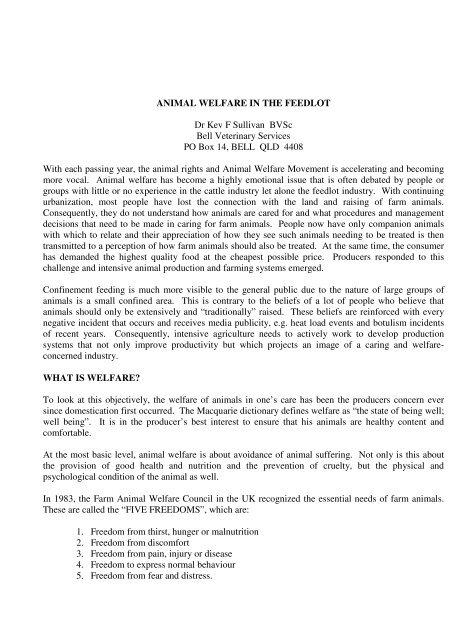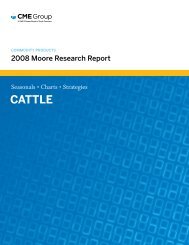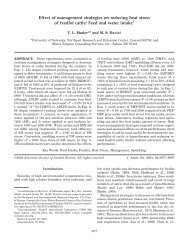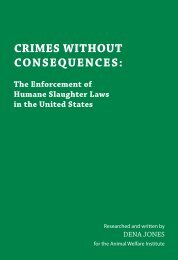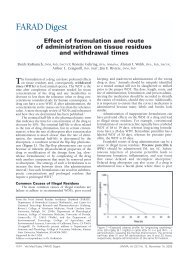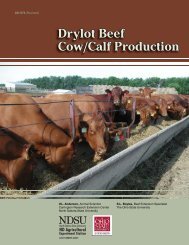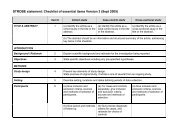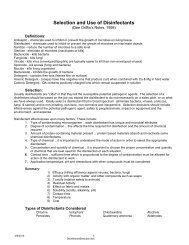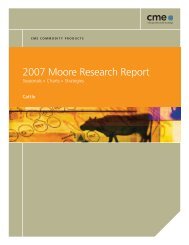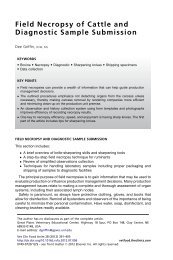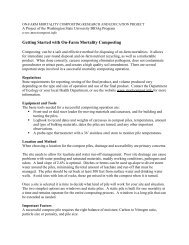ANIMAL WELFARE IN THE FEEDLOT Dr Kev F Sullivan ... - gpvec
ANIMAL WELFARE IN THE FEEDLOT Dr Kev F Sullivan ... - gpvec
ANIMAL WELFARE IN THE FEEDLOT Dr Kev F Sullivan ... - gpvec
Create successful ePaper yourself
Turn your PDF publications into a flip-book with our unique Google optimized e-Paper software.
<strong>ANIMAL</strong> <strong>WELFARE</strong> <strong>IN</strong> <strong>THE</strong> <strong>FEEDLOT</strong><br />
<strong>Dr</strong> <strong>Kev</strong> F <strong>Sullivan</strong> BVSc<br />
Bell Veterinary Services<br />
PO Box 14, BELL QLD 4408<br />
With each passing year, the animal rights and Animal Welfare Movement is accelerating and becoming<br />
more vocal. Animal welfare has become a highly emotional issue that is often debated by people or<br />
groups with little or no experience in the cattle industry let alone the feedlot industry. With continuing<br />
urbanization, most people have lost the connection with the land and raising of farm animals.<br />
Consequently, they do not understand how animals are cared for and what procedures and management<br />
decisions that need to be made in caring for farm animals. People now have only companion animals<br />
with which to relate and their appreciation of how they see such animals needing to be treated is then<br />
transmitted to a perception of how farm animals should also be treated. At the same time, the consumer<br />
has demanded the highest quality food at the cheapest possible price. Producers responded to this<br />
challenge and intensive animal production and farming systems emerged.<br />
Confinement feeding is much more visible to the general public due to the nature of large groups of<br />
animals is a small confined area. This is contrary to the beliefs of a lot of people who believe that<br />
animals should only be extensively and “traditionally” raised. These beliefs are reinforced with every<br />
negative incident that occurs and receives media publicity, e.g. heat load events and botulism incidents<br />
of recent years. Consequently, intensive agriculture needs to actively work to develop production<br />
systems that not only improve productivity but which projects an image of a caring and welfareconcerned<br />
industry.<br />
WHAT IS <strong>WELFARE</strong>?<br />
To look at this objectively, the welfare of animals in one’s care has been the producers concern ever<br />
since domestication first occurred. The Macquarie dictionary defines welfare as “the state of being well;<br />
well being”. It is in the producer’s best interest to ensure that his animals are healthy content and<br />
comfortable.<br />
At the most basic level, animal welfare is about avoidance of animal suffering. Not only is this about<br />
the provision of good health and nutrition and the prevention of cruelty, but the physical and<br />
psychological condition of the animal as well.<br />
In 1983, the Farm Animal Welfare Council in the UK recognized the essential needs of farm animals.<br />
These are called the “FIVE FREEDOMS”, which are:<br />
1. Freedom from thirst, hunger or malnutrition<br />
2. Freedom from discomfort<br />
3. Freedom from pain, injury or disease<br />
4. Freedom to express normal behaviour<br />
5. Freedom from fear and distress.
-2-<br />
<strong>Dr</strong> David Mellor developed a graphic depiction of the 5 freedoms, which he calls the five domains of<br />
potential welfare compromise (See figure 1).<br />
Figure 1 – Five Domains of Potential Welfare Compromise<br />
If these five freedoms are examined, one might conclude that these requirements can be met by good<br />
husbandry practices. This may well be so, but the critics of intensive livestock systems argue that the<br />
system creates mass “suffering” to the confined animals, because the animals are not in their natural<br />
environment and so cannot exhibit their full range of instinctive behaviours.<br />
Science has shown that there is a strong correlation between an animal’s health and situations that cause<br />
it to experience fear, anxiety or frustration and that its productivity is also affected both directly and<br />
indirectly. Animals will suffer fear and/or anxiety simply due to the way they are handled. The attitude<br />
of the stockman towards stock will affect productivity (see figure 2).<br />
Attitude of stock<br />
person<br />
1<br />
THIRST<br />
HUNGER<br />
MALNUTRITION<br />
4<br />
BEHAVIOURAL<br />
<strong>IN</strong>TERACTIVE<br />
RESTRICTION<br />
Behaviour of<br />
stock person<br />
5<br />
ANXIETY<br />
FEAR<br />
PA<strong>IN</strong><br />
DISTRESS<br />
Fear by animals<br />
of humans<br />
Figure 2 – Chain Reaction Between Stock Person and Animal<br />
2<br />
ENVIRONMENTAL<br />
CHALLENGE<br />
3<br />
DISEASE<br />
<strong>IN</strong>JURY<br />
FUNCTIONAL<br />
IMPAIRMENT<br />
Productivity, health and<br />
welfare (acute and<br />
chronic stress response)
STRESS:<br />
-3-<br />
Stress has been defined as the mental and physical responses to external stimuli. Prolonged stress<br />
(distress) from adverse or negative stimuli results in inappropriate or extreme responses to the detriment<br />
of health and performance. The most effective feedlot health programmes are based upon stress<br />
management.<br />
What are some of the potential stressors that feedlot cattle have to contend with? There are stressors that<br />
occur prior to animals arriving at the feedlot, even if animals are sourced directly from the property on<br />
which they were bred. The act of mustering, yarding, drafting, weighing, loading and trucking are all<br />
unfamiliar and therefore stressful events. Often cattle may be held prior to trucking without access to<br />
good quality feed.<br />
Cattle purchased from sale yards have another set of stressors imposed upon them. These animals are<br />
subjected to strange surroundings, lots of noise, people, dogs, goads and prodders, other strange cattle,<br />
lots of vehicular movement and protracted periods of no food or water. They are also in all likelihood<br />
being mixed with strange cattle. These cattle are then loaded onto another truck and undergo a further<br />
trip of sometimes more than 1,000 km before they arrive at the feedlot. These stressors are cumulative<br />
and so when these cattle arrive at the feedlot, they can be suffering from quite high levels of stress.<br />
The total time in transit from mustering to feedlot arrival can, in some instances, be more than 1 week.<br />
Once the cattle arrive at the feedlot, they are tired, dehydrated, frightened, thirsty and hungry with<br />
reduced rumen function and possibly bruised or injured and disoriented. These animals are unloaded<br />
and placed in receival pens with feed of varying quality and water, which may be of different taste and<br />
quality. Receival pens are often overcrowded.<br />
Within a few days of arrival, the cattle are processed, worked through yards, co-mingled again and<br />
placed in a feeding pen. Here they have to find the water, which may taste very different. There is no<br />
grass so they have to find the bunk, which may have no feed in it or it may be filled with some<br />
unfamiliar and uninteresting feed.<br />
This is indeed a very stressful period in the animal’s life, which can severely compromise the animal’s<br />
health and welfare.
MEASURES OF <strong>ANIMAL</strong> <strong>WELFARE</strong>:<br />
-4-<br />
Assessing or measuring the welfare status of animals is fraught with danger because often human values<br />
have been made to equate to animal values. This is perception and not fact and must always be viewed<br />
as such until some objective measurements of stress are developed.<br />
Measure of Poor Welfare:<br />
• Lowered life expectancy<br />
• Behavioural pathology (vice, e.g. body and tail biting, bulling)<br />
• Lowered ability to grow/breed<br />
• Body damage<br />
• Extent of behavioural aversion shown<br />
• Disease<br />
• Immunosuppression<br />
• Extent to which normal physiological and anatomical development are prevented<br />
• Physiological attempts to cope<br />
• Behavioural attempts to cope.<br />
The ability to cope declines as stressors increase.<br />
Stress<br />
Cortisol Production<br />
Immunosuppression<br />
Reduced Disease Defense<br />
Disease
Measures of Good Welfare:<br />
A variety of normal behaviours are shown:<br />
-5-<br />
• Physiological indicators (e.g. normal respiration)<br />
• Behavioural indicators (e.g. sitting down and cud chewing).<br />
<strong>FEEDLOT</strong> PRODUCTION PRACTICES OF CONCERN:<br />
Stressors:<br />
Little can be done about to level of co-mingling that occurs at the sale yards. However at the feedlot<br />
have adequate, well-designed receival pens and minimizing the time to fill a pen and the number of<br />
purchase groups in a pen. Avoid excessive sorting and re-mingling of cattle. Ensure cattle are<br />
processed within 3 days of arrival if possible. Rest tired cattle for at least 24 hours before processing.<br />
Branding:<br />
It is unlikely that with the introduction of the NLIS, fire branding at arrival will survive as an acceptable<br />
feedlot procedure. Branding should be discontinued or minimized as much as possible.<br />
Dehorning:<br />
Dehorning should not be done in animals over 8 months of age and should not be done at feedlot entry.<br />
This is an uneconomic procedure more so than inhumane. Dehorning needs to be done on property as<br />
calves. The promotion of polled bulls and breeds will reduce the number or horned animals. For<br />
animals that do arrive with horns, only tip to no shorter than ear length.<br />
Castration:<br />
Having entire bulls arriving at feedlots is not very common. Mature bulls can be fed as entire and in<br />
small groups without any undesirable behaviour. Young bulls need to be castrated to prevent injuries<br />
from bulling and fighting. Banding is preferable to surgical castration due to the risk of tetanus.<br />
Feedlot Abortion:<br />
When feeding heifers, it is inevitable that some will be pregnant. To avoid this, buyers should only<br />
purchase pregnancy tested negative heifers that have been tagged as such. However this can be difficult<br />
when purchasing heifers from saleyards. Pregnancy testing and aborting heifers at the feedlot is a cost<br />
effective alternative with pregnancy rates as low as 3-4%. Most feedlot veterinarians would argue that<br />
an abortion program is predictable and can be managed and is preferable than random calvings that are<br />
usually complicated with an emphysematous fetus, calving paralysis or retained placenta and metritis.
Poor Animal Husbandry Practices:<br />
-6-<br />
The most common problem in this area is the delay in making a decision to euthanase animals to prevent<br />
any further suffering. Simple documented guidelines for the euthanasia of animals need to be drawn up.<br />
Some examples are:<br />
• If an animal is recumbent and cannot get up to access feed and water without goading, it<br />
should be euthanased unless the animal is down due to a treatable condition.<br />
• An animal that has sustained a broken leg should be euthanased immediately.<br />
• Chronic respiratory cases where the animal is distressed and becoming emaciated should be<br />
euthanased.<br />
• If an animal is unable to walk onto a truck without goading.<br />
Handling Cattle:<br />
Working cattle often provokes a level of stress not only in cattle, but in handlers as well. Poor cattle<br />
handling skills is a common problem encountered on many feedlots. This is not surprising with an<br />
increasing number of stock people who have little or no stock experience prior to joining the feedlot<br />
team. There are a large number of people who do not possess cattle handling skills of a suitable<br />
standard. This is often manifest by the amount of hollering and use of electric prodders that occur.<br />
Training programmes to teach correct cattle handling techniques need to be included in every feedlot<br />
training curriculum. The main areas are in the processing and dispatch area and the hospital. These are<br />
very stressful areas for cattle to be in.<br />
Facilities:<br />
Facilities must be designed to facilitate cattle movement with maximum ease and without injury. Poor<br />
facility design will lead to cattle “balking”. This will lead to increased frustration for man and beast and<br />
an increased temptation to use goads, sticks and prodders will occur. Unnecessary noise by equipment<br />
and frustrated personnel will add to the problem inducing high levels of stress and fear in the cattle.<br />
Pen Condition:<br />
The condition of the pen where the cattle are confined can cause extreme discomfort. High mud levels<br />
in wet weather and excessive dust in dry conditions can cause a lot of stress in cattle. Management of<br />
the manure levels is paramount to controlling these conditions.<br />
Shade needs to be considered in all feedlots. ALFA has a heat load risk assessment programme<br />
designed to determine what is required to manage heat load in any given site. The hospitals should be<br />
shaded.
-7-<br />
Overcrowding can result in any number of problems including erratic feeding patterns and consumption,<br />
excessive wear and tear on the pads around the water troughs and behind the bunk pad. Overcrowding<br />
may also contribute significantly to the severity of the “buller” problem.<br />
SELECTION OF <strong>ANIMAL</strong>S FOR SLAUGHTER:<br />
Each state and territory has its own animal welfare Act and accompanying regulations that affect people<br />
who own or work with animals including farmers, livestock transporters, saleyard personnel and<br />
processors. Under these Acts, it is an offence to transport, confine, restrain or catch an animal in a way<br />
that causes, or is likely to cause, it unnecessary harm.<br />
Recently there has been an increase in the number of complaints emanating from abattoir veterinarians<br />
with respect to the condition of cattle at arrival at the abattoir.<br />
An animal is fit to travel if it:<br />
• Is strong enough to undertake the journey.<br />
• Can walk normally, bearing weight on all four legs.<br />
• Is not suffering from any visible disease or injury that could cause it harm during transport.<br />
• Can keep up with the mob both at loading and unloading.<br />
• Is suitable for transport according to the relevant code (special codes for young animals, drought<br />
or bushfire animals, etc).<br />
• Is not late in pregnancy (8 months).<br />
Pre Transport Preparation:<br />
• Ensure dispatch yards and loading ramp is adequate for the job.<br />
• Plan the journey.<br />
• Ensure the truck and crate or trailer is safe and of a design that will not cause harm to the<br />
livestock.<br />
• Avoid weather extremes, where practicable.
-8-<br />
WHAT SHOULD NOT BE SENT TO <strong>THE</strong> ABATTOIR:<br />
There is considerable variation between abattoirs as to what is considered acceptable and what is not.<br />
What can be slaughtered is up to the discretion of the plant veterinarian following the ante-mortem<br />
inspection.<br />
Animals that should not be sent are:<br />
• Animals that cannot bear weight on all fore legs.<br />
• Animals that cannot walk up the ramp on its own without excessive goading.<br />
• Open wounds.<br />
• Emaciated animals.<br />
• Abscesses bigger than a grapefruit.<br />
• Pussy discharges from joints or lesions.<br />
• Cancer eye –eye discharging and cannot see.<br />
• More than 8 months pregnant.<br />
• Animals that are clinically sick.<br />
How To Be Prepared For An Inspection If There Is A Complaint?<br />
To ensure that the feedlot is prepared to defend its position in the face of a complaint, a documented<br />
protocol should be put in place and be part of the QA system. It is important to keep a record of all<br />
suspect animals that are dispatched. This should include the animals ID, what the problem is and a<br />
description of it. Describe how it walks if it is lame. Further documentation may take the form of<br />
photos or a short digital video clip of each animal.<br />
Another part of the process is the training of dispatch people in the ante-mortem inspection process to<br />
avoid sending unacceptable cattle.<br />
If an animal is unfit for slaughter, then if must be euthanased.<br />
Euthanasia and Humane Destruction of Cattle:<br />
Euthanasia is performed by using either a firearm or a captive bolt. People involved in euthanasing<br />
animals by using firearms need to have a firearm license. Euthanasia needs to be quick and reliable to<br />
relieve suffering and to be done sooner rather later. It is unacceptable to let animals suffer longer than is<br />
necessary. Select personnel who are suitable to euthanase animals. Not all people are comfortable with<br />
euthanasing animals and the decision not to do so should be respected.<br />
There are three suitable methods for euthanasing cattle. These are:<br />
• Temporal method (firearm only).<br />
• Frontal method (firearm or captive bolt).<br />
• Poll method (firearm only).
CONCLUSION:<br />
-9-<br />
It is important to have an understanding of animal welfare and animal well-being. The feedlot industry<br />
needs to pay attention to the concerns of welfare organizations and work with them on issues of welfare.<br />
This has been done in the issue of heat load, with good results to date. There is a perception in the<br />
community that feedlots are a stressful environment for cattle causing mass “suffering”. This is<br />
certainly not the case in a well-designed, well-managed feedlot with well-trained personnel.<br />
The importance of stress in the health and welfare of cattle has been established and there are several<br />
situations that can be classified under the heading of stress. These are:<br />
• Thirst, hunger and malnutrition.<br />
• Environmental change.<br />
• Disease, injury, and functional impairment.<br />
• Behavioural, interactive restriction.<br />
• Anxiety, fear, pain and distress.<br />
Animals will suffer from such stressors if they are handled incorrectly. It is important to remember that<br />
the level of stress will be determined by the attitude of the handler. Relaxed, calm and confident<br />
handlers will have relaxed cattle. The welfare and well-being of the animal should always be the<br />
number one priority of people who are handling livestock.<br />
A number of feedlot practices that have the potential to be an area of poor animal welfare were<br />
discussed. It is important that unsuitable animals are not sent to slaughter and animals that are unable to<br />
be slaughtered or are suffering should be euthanased in a humane way as soon as possible.


